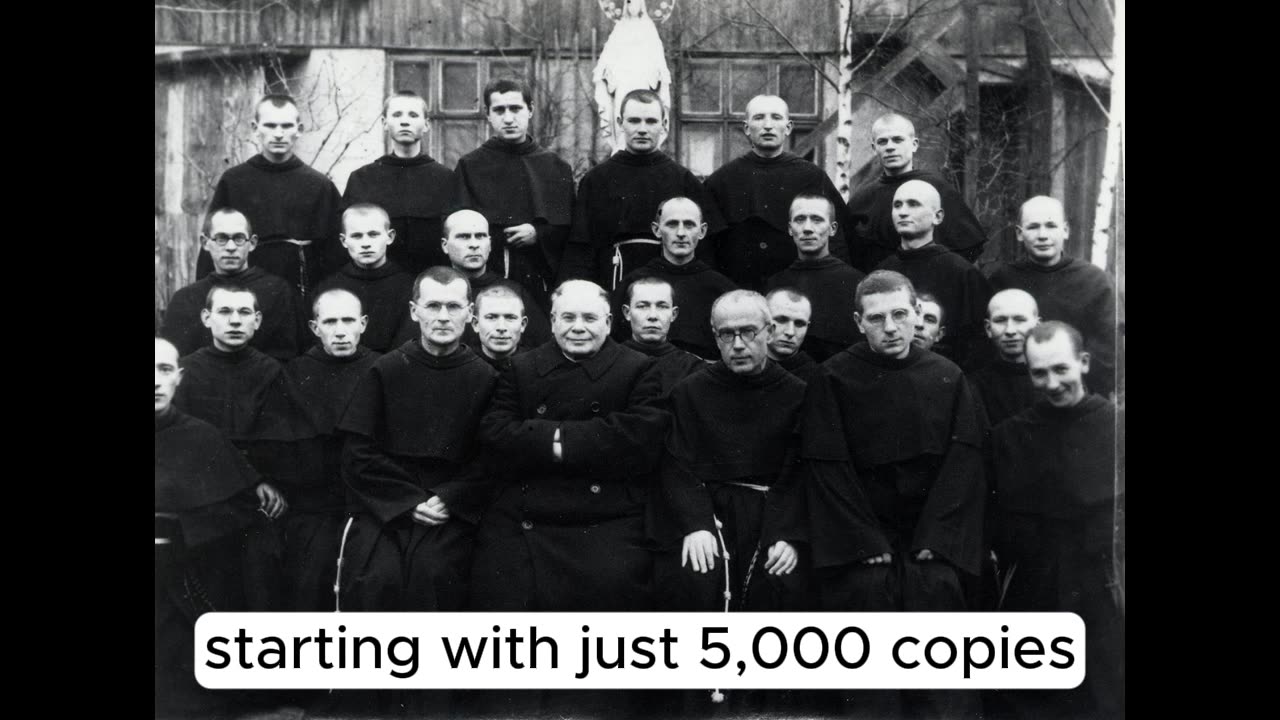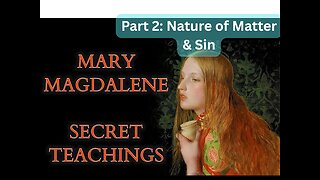Premium Only Content

Summary of the life of Saint Maximilian Kolbe
Summary of the life of Saint Maximilian Kolbe
Full text available here or below:
https://medium.com/@doubtingtomasz/summary-of-the-life-of-saint-maximilian-kolbe-71ace2cde235
Saint Maximilian Kolbe: A Comprehensive Life Summary
Early Life and Formation (1894–1918)
Rajmund Kolbe was born on January 8, 1894, in Zduńska Wola, in the Russian partition of Poland. He was the second of five sons born to Julius Kolbe, a weaver, and Maria Dąbrowska Kolbe. His childhood was marked by deep religious devotion and a strong sense of Polish patriotism during a time when Poland was divided among three empires.
At age 10, Rajmund experienced a pivotal vision of the Virgin Mary, who appeared to him holding two crowns — one white representing purity, the other red representing martyrdom. When she asked which he would choose, he reportedly said “both,” a response that would prove prophetic.
In 1907, at age 13, Rajmund joined his older brother Francis in entering the Conventual Franciscan minor seminary in Lwów. He took the religious name Maximilian upon entering the novitiate in 1910. He was known for his brilliance in mathematics and physics, initially considering a career in engineering before fully committing to religious life.
Education and Early Priesthood (1912–1927)
Kolbe was sent to Rome for advanced studies, where he earned doctorates in philosophy (1915) and theology (1919) from the Pontifical Gregorian University. During his time in Rome, he was deeply troubled by the anti-Catholic demonstrations he witnessed, particularly those by Freemasons celebrating the anniversary of Giordano Bruno’s birth.
This experience led him to found the Militia Immaculata (Army of the Immaculate One) in 1917, with six other seminarians. The organization was dedicated to promoting devotion to the Immaculate Heart of Mary and working for the conversion of sinners, heretics, and especially Freemasons. He was ordained a priest on April 28, 1918.
Upon returning to Poland in 1919, Kolbe began teaching at the Kraków seminary while spreading devotion to the Immaculate Conception. However, his health was fragile due to tuberculosis, which he had contracted during his studies.
The Publishing Apostolate (1922–1930)
In 1922, despite limited resources, Kolbe began publishing “Knight of the Immaculata,” a monthly magazine promoting Marian devotion. Starting with just 5,000 copies, circulation grew dramatically, reaching 750,000 by 1938, making it one of the most widely read Catholic publications in the world.
The success of the magazine led to the establishment of Niepokalanów (City of the Immaculate One) in 1927, about 25 miles from Warsaw. This became one of the largest religious communities in the world, housing nearly 800 friars at its peak. The community operated a sophisticated printing operation, producing not only the magazine but also books, newspapers, and other religious materials.
Niepokalanów was remarkable for its use of modern technology in service of evangelization. Kolbe embraced radio broadcasting, established one of Poland’s first Catholic radio stations, and even planned television broadcasts. He saw modern media as powerful tools for spreading the Gospel and Marian devotion.
Mission to Japan (1930–1936)
In 1930, despite his poor health, Kolbe embarked on a missionary journey to Japan with four other friars. Working in Nagasaki, he learned Japanese and established a Japanese version of “Knight of the Immaculata” called “Seibo no Kishi.” He also founded a monastery called Mugenzai no Sono (Garden of the Immaculate).
His work in Japan was challenging due to cultural and linguistic barriers, but he persevered with characteristic determination. Interestingly, the Nagasaki monastery was built on a mountainside that was shielded from the atomic bomb blast in 1945, and the community survived while much of the city was destroyed.
Kolbe also made brief missionary attempts in India before returning to Poland in 1936 due to his deteriorating health and the growing political tensions in Europe.
Return to Poland and World War II (1936–1941)
Back at Niepokalanów, Kolbe resumed his publishing work and expanded the community’s activities. When World War II began in September 1939, he remained at the monastery despite the danger. As German forces occupied Poland, Kolbe transformed Niepokalanów into a refuge for thousands of Polish refugees, including approximately 2,000 Jews whom he helped hide and assist.
He continued publishing, though under severe restrictions, using the press to counter Nazi propaganda and maintain Polish morale. The Germans temporarily arrested him in September 1939 but released him. However, his continued resistance activities and protection of Jews made him a marked man.
Arrest and Imprisonment (1941)
On February 17, 1941, the Gestapo arrested Kolbe along with four other friars. He was first imprisoned in Pawiak prison in Warsaw, where he continued his ministry among fellow prisoners, hearing confessions and celebrating Mass in secret.
In May 1941, he was transferred to Auschwitz concentration camp, where he was assigned prisoner number 16670. Despite the horrific conditions, Kolbe maintained his faith and helped fellow prisoners spiritually and physically. He shared his meager rations, heard confessions, and conducted clandestine religious services.
Fellow prisoners later testified that Kolbe remained serene and prayerful even in the face of brutal treatment. He was beaten more severely than others because of his status as a priest and intellectual, but witnesses reported that he never complained or showed hatred toward his captors.
The Ultimate Sacrifice (July-August 1941)
In late July 1941, a prisoner escaped from Kolbe’s block. As punishment, the camp commandant selected ten prisoners to be starved to death in an underground bunker. When Franciszek Gajowniczek, a married man with children, was selected, Kolbe stepped forward and volunteered to take his place.
The commandant, surprised by this unprecedented act, accepted the substitution. Kolbe was placed in the starvation bunker with nine other condemned men. During the two weeks that followed, guards reported hearing prayers and hymns coming from the bunker, led by Kolbe who provided spiritual comfort to his fellow victims.
As the other prisoners gradually died, Kolbe remained alive, sustained by his faith and determination to serve others until the end. On August 14, 1941, impatient guards killed him with a lethal injection of carbolic acid. He was 47 years old.
Legacy and Canonization
Kolbe’s sacrifice became legendary among Auschwitz survivors. Franciszek Gajowniczek, the man whose life he saved, survived the war and lived until 1995, becoming a witness to Kolbe’s heroism.
Pope Paul VI beatified Maximilian Kolbe in 1971, initially as a confessor. However, after extensive investigation and testimony from survivors, Pope John Paul II canonized him in 1982 as a martyr of charity, emphasizing that his death was motivated by love rather than hatred of the faith.
The canonization ceremony in St. Peter’s Square was attended by approximately 150,000 people, including Franciszek Gajowniczek and many concentration camp survivors. John Paul II, himself Polish, declared Kolbe a “martyr of charity” and praised his “spiritual victory over the mentality of contempt and hatred.”
Kolbe is the patron saint of drug addicts, political prisoners, families, journalists, prisoners, and the pro-life movement. His feast day is celebrated on August 14, the anniversary of his death.
Theological and Spiritual Significance
Kolbe’s life exemplified several key themes in Catholic spirituality:
Marian Devotion: His intense devotion to Mary as the Immaculate Conception shaped his entire life and ministry. He saw Mary as the perfect model of surrender to God’s will and the most effective intercessor for sinners.
Modern Evangelization: He was a pioneer in using modern media and technology for evangelization, recognizing their potential to reach vast audiences with the Gospel message.
Martyrdom of Love: His death represented a new form of martyrdom — dying not because of hatred for the faith, but because of heroic Christian love and self-sacrifice.
Universal Brotherhood: His willingness to die for a stranger demonstrated the Christian principle that all humans are brothers and sisters in Christ.
Prophetic Witness: His protection of Jews and resistance to Nazi ideology demonstrated the prophetic role of Christianity in opposing evil and defending human dignity.
Contemporary Relevance
Saint Maximilian Kolbe’s life continues to inspire people worldwide as an example of heroic virtue in the face of ultimate evil. His story demonstrates how faith can triumph over hatred, how love can conquer death, and how individual acts of sacrifice can have eternal significance.
His embrace of modern media for evangelization remains particularly relevant in our digital age, and his example of intercultural ministry in Japan provides a model for contemporary missionary work. Most significantly, his ultimate sacrifice reminds us that the greatest love is shown by those who lay down their lives for others.
In a world still marked by persecution, hatred, and violence, Saint Maximilian Kolbe stands as a beacon of hope, showing that even in humanity’s darkest moments, the light of Christian love can shine brightly and transform the world.
Main Vatican Documents:
Canonization Homily (October 10, 1982) — Pope John Paul II:
Italian version: https://www.vatican.va/content/john-paul-ii/it/homilies/1982/documents/hf_jp-ii_hom_19821010_canonizzazione-kolbe.html
This appears to be the primary canonization document
Speech to Pilgrims (October 11, 1982) — Pope John Paul II:
Referenced at: https://www.vatican.va/content/john-paul-ii/en/speeches/1982/october.index.2.html
Available in Italian, Polish, and Portuguese 12 December 2010: Pastoral Visit to the Roman Parish of St. Maximilian Kolbe on the via Prenestina [Torre Angela] | BENEDICT XVI
Speech at Auschwitz (June 7, 1979) — Pope John Paul II:
https://www.vatican.va/content/john-paul-ii/en/homilies/1979/documents/hf_jp-ii_hom_19790607_polonia-brzezinka.html
This was before the canonization but mentions Kolbe
Speech in Chapel dedicated to Blessed Maximilian Kolbe (February 18, 1979):
https://www.vatican.va/content/john-paul-ii/en/speeches/1979/february/documents/hf_jp-ii_spe_19790218_magliana.html
-
 5:11
5:11
Doubting Tomasz 2.0
3 days agoGospel of Mary Magdalene - 5 Verses on the Nature of Matter and Sin
14 -
 LIVE
LIVE
Right Side Broadcasting Network
15 hours agoLIVE: President Trump Makes an Announcement - 11/6/25
6,320 watching -
 1:42:05
1:42:05
Graham Allen
3 hours agoTrump And Vance Show The Path For Winning!!! WE MUST FIGHT! + Erika Kirk Reveals All!
117K40 -
 LIVE
LIVE
LadyDesireeMusic
2 hours ago $0.02 earnedLive Piano & Convo - Rumble Rants and Sub Request
232 watching -
 1:10:27
1:10:27
Chad Prather
18 hours agoThe Secret To Pleasing The Lord Over Man!
82.5K53 -
 LIVE
LIVE
LFA TV
13 hours agoLIVE & BREAKING NEWS! | THURSDAY 11/6/25
4,433 watching -
 52:16
52:16
American Thought Leaders
20 hours agoIs There a Link Between Mass Shootings and SSRIs?
63.3K58 -
 17:12
17:12
World2Briggs
21 hours ago $0.09 earnedTop 10 Towns You Can Retire or Live on $1900 a month in the Midwest #1
46.2K26 -
 17:25
17:25
BlackDiamondGunsandGear
1 day agoCustom Building the Cheapest MP5
52.7K2 -
 2:07:20
2:07:20
BEK TV
1 day agoTrent Loos in the Morning - 11/06/2025
47.9K1